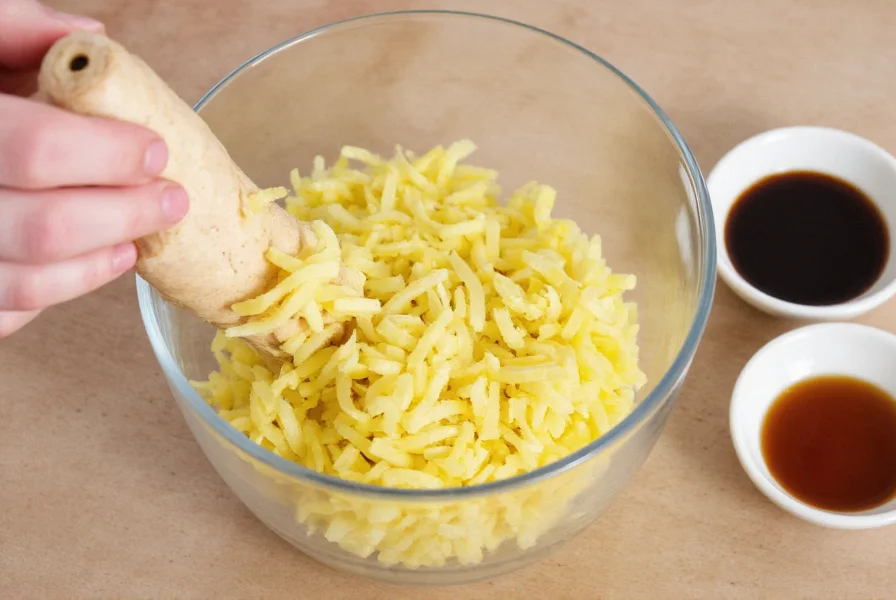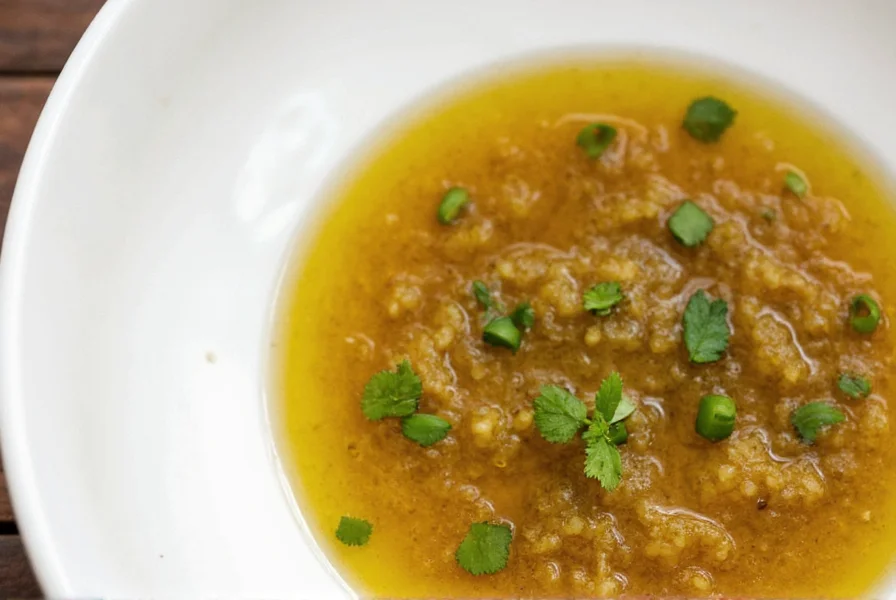Ginger vinaigrette transforms ordinary salads into vibrant culinary experiences with its perfect balance of zesty, sweet, and savory notes. This Asian-inspired dressing has gained popularity among home cooks and professional chefs alike for its versatility and health benefits. Unlike store-bought alternatives filled with preservatives, homemade ginger vinaigrette lets you control ingredients and tailor flavors to your preference.
The Essential Ginger Vinaigrette Recipe
Creating an exceptional ginger vinaigrette starts with quality ingredients and proper technique. This foundational recipe yields approximately 1 cup of dressing and serves as the perfect base for customization.
| Ingredient | Amount | Key Function |
|---|---|---|
| Fresh ginger root | 2 tablespoons, finely grated | Provides signature spicy warmth and aromatic complexity |
| Rice vinegar | 3 tablespoons | Offers mild acidity that complements Asian flavors |
| Soy sauce or tamari | 2 tablespoons | Contributes umami depth and saltiness |
| Neutral oil (avocado or grapeseed) | 6 tablespoons | Creates emulsion and carries flavors |
| Sesame oil | 1 teaspoon | Adds distinctive nutty aroma |
| Maple syrup or honey | 1-2 tablespoons | Counterbalances acidity with natural sweetness |
Step-by-Step Preparation Guide
Follow these professional techniques to achieve restaurant-quality results every time:
- Prepare fresh ginger: Peel ginger root using a spoon's edge (gentler than a knife), then finely grate using a microplane. This extracts maximum flavor without fibrous bits.
- Create the base: In a glass measuring cup or small bowl, combine rice vinegar, soy sauce, maple syrup, and grated ginger. Whisk thoroughly to dissolve sweetener.
- Emulsify properly: Slowly drizzle neutral oil into the mixture while continuously whisking. This gradual incorporation creates a stable emulsion that won't separate quickly.
- Finish with sesame oil: Stir in sesame oil last to preserve its delicate flavor compounds.
- Rest and blend: Let the dressing sit for 15 minutes before use, then whisk again. This allows flavors to meld while maintaining texture.
Ingredient Science: Why Each Component Matters
Understanding the role of each ingredient elevates your ginger vinaigrette from good to exceptional:
Fresh vs. ground ginger: Freshly grated ginger contains volatile compounds that provide brighter, more complex flavor than dried ginger powder. The enzymatic action in fresh ginger also creates subtle flavor transformations during resting.
Vinegar selection: Rice vinegar's mild acidity (4-5% acetic acid) works better than stronger vinegars which can overwhelm delicate ginger notes. For a tangier profile, substitute 1 tablespoon with apple cider vinegar.
Sweetener balance: The sugar-to-acid ratio determines whether your dressing tastes flat or vibrant. Start with 1 tablespoon sweetener, then adjust to taste after emulsifying. Maple syrup adds caramel notes while honey provides floral undertones.
Flavor Variations for Different Cuisines
Adapt your ginger vinaigrette for various culinary applications with these professional modifications:
- Spicy Thai version: Add 1 teaspoon sriracha and 1 tablespoon lime juice for a dressing perfect with mango salads
- Miso-enhanced: Whisk in 1 tablespoon white miso paste for added umami depth that complements roasted vegetables
- Citrus-forward: Replace half the rice vinegar with yuzu or mandarin orange juice for a brighter profile
- Herb-infused: Blend in 2 tablespoons chopped cilantro or Thai basil for fresh herbal notes

Ideal Pairings for Ginger Vinaigrette
This versatile dressing shines with specific food combinations that highlight its unique flavor profile:
Salad foundations: Works exceptionally with bitter greens like radicchio and endive, which balance the dressing's sweetness. Also excellent with shredded cabbage, cucumber ribbons, and baby spinach.
Protein pairings: Complements grilled salmon, sesame-crusted tuna, and citrus-marinated chicken. The acidity cuts through rich proteins while ginger notes enhance savory flavors.
Vegetable applications: Toss with roasted sweet potatoes, asparagus, or Brussels sprouts. Drizzle over steamed bok choy or use as a dipping sauce for spring rolls.
Storage and Shelf Life Guidelines
Proper storage maintains flavor integrity and food safety:
- Store in an airtight glass container in the refrigerator
- Shelf life: Up to 14 days (discard if separation becomes permanent or odor changes)
- Before use, shake vigorously or re-whisk to re-emulsify
- Do not freeze, as this damages the emulsion and alters ginger's texture
For meal prep enthusiasts, prepare dressing components separately (keep ginger paste in one container, oil mixture in another) and combine just before use for maximum freshness.
Troubleshooting Common Issues
Resolve these frequent ginger vinaigrette problems with professional solutions:
Problem: Dressing separates immediately
Solution: Ensure you're adding oil slowly while whisking constantly. Use room temperature ingredients, as cold ingredients resist emulsification.
Problem: Overpowering ginger heat
Solution: Balance with additional sweetener or acid. For future batches, use younger ginger (paler skin) which is milder than mature ginger.
Problem: Bland flavor profile
Solution: Increase ginger quantity by 50% or add 1/4 teaspoon toasted sesame seeds blended into the dressing for nutty depth.

Frequently Asked Questions
Can I substitute apple cider vinegar for rice vinegar in ginger vinaigrette?
Yes, but with adjustments. Apple cider vinegar has stronger flavor and higher acidity (5-6% vs rice vinegar's 4-5%). Use 2 tablespoons apple cider vinegar plus 1 tablespoon water to match rice vinegar's mildness. This substitution works particularly well with heartier greens like kale.
How can I make ginger vinaigrette without sesame oil?
Create a sesame-free version by replacing sesame oil with an additional 1/2 tablespoon of neutral oil plus 1/4 teaspoon toasted sesame seeds blended into the dressing. For nut-free requirements, omit sesame entirely and add 1/8 teaspoon smoked paprika for depth. The dressing will lack traditional nuttiness but maintain excellent flavor balance.
Why does my homemade ginger vinaigrette taste different from restaurant versions?
Restaurant versions often use ginger juice extracted through cheesecloth rather than grated ginger, resulting in smoother texture. They may also incorporate mirin (sweet rice wine) for complexity and use higher oil ratios (3:1 instead of 2:1). For closer replication, blend grated ginger with vinegar, strain through fine mesh, and use a 3:1 oil-to-acid ratio.
Can I use this ginger vinaigrette as a marinade?
Absolutely. Ginger vinaigrette makes an excellent marinade for proteins and vegetables. For best results, marinate proteins for 30-60 minutes (no longer than 2 hours for fish, 4 hours for chicken). The acid in the dressing tenderizes while ginger enzymes enhance flavor penetration. Reserve some unmarinated dressing for serving to avoid cross-contamination.











 浙公网安备
33010002000092号
浙公网安备
33010002000092号 浙B2-20120091-4
浙B2-20120091-4